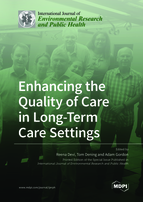Enhancing the Quality of Care in Long-Term Care Settings
A special issue of International Journal of Environmental Research and Public Health (ISSN 1660-4601). This special issue belongs to the section "Health Care Sciences & Services".
Deadline for manuscript submissions: closed (1 May 2021) | Viewed by 77433
Special Issue Editors
Interests: epidemiological studies of very old people; mental health services for older people; mental health in care homes
Interests: health care services; older people, long-term care, and implementation science
Interests: care of older people; healthcare professions; long-term care
Special Issues, Collections and Topics in MDPI journals
Special Issue Information
Dear Colleagues,
The increasing older population is a phenomenon that is well recognised around the world. The number of people aged 60 years and older will increase from 900 million in 2015 to 2 billion in 2050 (World Health Organisation 2018) (https://www.who.int/news-room/fact-sheets/detail/ageing-and-health). The most vulnerable and frail, who are not able to live independently, will live in residential care. Residential care settings provide 24-hour functional support for people with health and care needs, may/may not be staffed with health care professionals, provide long-term care and/or rehabilitation, are not hospital based and may play a role in end-of-life care (Sanford et al., 2015). Over time, the care and health needs of older people are becoming increasingly complex (Kingston et al., 2018), and there is work to do to ensure that the sector delivers high-quality and evidence-based care that meets the needs of older people.
This Special Issue on ‘Enhancing the Quality of Care in Long-Term Care Settings’ is dedicated to publishing reports, which describe different ways that the quality of care delivered to older people living in long-term care settings can be enhanced. The aim is to give readers valuable insights into what works well when working towards enhancing the quality of care received by older people. The guest editors would like to invite original research, reviews, and narratives describing expert insights on the following topics:
- Methodologies used to enhance the quality of care;
- Evaluations of innovations implemented into long-term care;
- Sustaining successful initiatives beyond the short term;
- Addressing workforce-related challenges;
- Advance care planning in long-term care;
- Supporting and delivering end-of-life care.
The title 'Enhancing the Quality of Care in Long Term Care Settings' was inspired from recent feedback received while working on a local project in the UK (https://medicinehealth.leeds.ac.uk/directory_record/1033/niche-leeds). The long term care sector described that the phrase 'quality improvement' implies poor quality as the starting point, and the phrase 'enhancing the quality of care' is preferred. Thank you to Cyd Akrill, Head of Operations at Springfield Healthcare (https://www.springfieldhealthcare.com/) for this excellent insight.
Prof. Tom Dening
Dr. Reena Devi
Prof. Adam Gordon
Guest Editors
Manuscript Submission Information
Manuscripts should be submitted online at www.mdpi.com by registering and logging in to this website. Once you are registered, click here to go to the submission form. Manuscripts can be submitted until the deadline. All submissions that pass pre-check are peer-reviewed. Accepted papers will be published continuously in the journal (as soon as accepted) and will be listed together on the special issue website. Research articles, review articles as well as short communications are invited. For planned papers, a title and short abstract (about 100 words) can be sent to the Editorial Office for announcement on this website.
Submitted manuscripts should not have been published previously, nor be under consideration for publication elsewhere (except conference proceedings papers). All manuscripts are thoroughly refereed through a single-blind peer-review process. A guide for authors and other relevant information for submission of manuscripts is available on the Instructions for Authors page. International Journal of Environmental Research and Public Health is an international peer-reviewed open access monthly journal published by MDPI.
Please visit the Instructions for Authors page before submitting a manuscript. The Article Processing Charge (APC) for publication in this open access journal is 2500 CHF (Swiss Francs). Submitted papers should be well formatted and use good English. Authors may use MDPI's English editing service prior to publication or during author revisions.
Keywords
- Long-term care
- Care homes
- Residential homes
- Nursing homes
- Implementation science
- Quality Improvement







